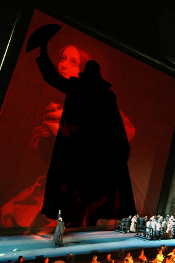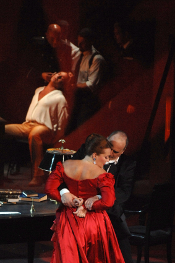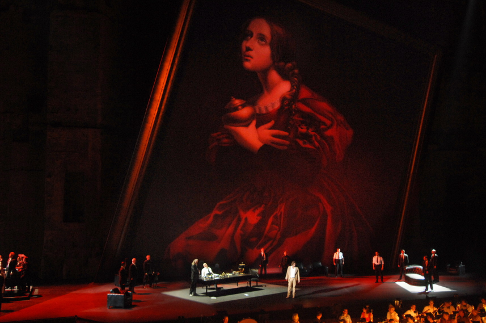![Catherine Naglestad as Tosca and Roberto Alagna as Cavaradossi [Photo by Photo Grand Angle Orange]](http://www.operatoday.com/Tosca_Orange_16.png)
18 Jul 2010
Tosca at Orange
There was a time when the likes of Luc Bondy and Francesca Zambello staged operas for the Chorégies d’Orange in its famed Théâtre Antique.
English Touring Opera are delighted to announce a season of lyric monodramas to tour nationally from October to December. The season features music for solo singer and piano by Argento, Britten, Tippett and Shostakovich with a bold and inventive approach to making opera during social distancing.
This tenth of ten Live from London concerts was in fact a recorded live performance from California. It was no less enjoyable for that, and it was also uplifting to learn that this wasn’t in fact the ‘last’ LfL event that we will be able to enjoy, courtesy of VOCES8 and their fellow vocal ensembles (more below …).
Ever since Wigmore Hall announced their superb series of autumn concerts, all streamed live and available free of charge, I’d been looking forward to this song recital by Ian Bostridge and Imogen Cooper.
The Sixteen continues its exploration of Henry Purcell’s Welcome Songs for Charles II. As with Robert King’s pioneering Purcell series begun over thirty years ago for Hyperion, Harry Christophers is recording two Welcome Songs per disc.
Although Stile Antico’s programme article for their Live from London recital introduced their selection from the many treasures of the English Renaissance in the context of the theological debates and upheavals of the Tudor and Elizabethan years, their performance was more evocative of private chamber music than of public liturgy.
In February this year, Albanian soprano Ermonela Jaho made a highly lauded debut recital at Wigmore Hall - a concert which both celebrated Opera Rara’s 50th anniversary and honoured the career of the Italian soprano Rosina Storchio (1872-1945), the star of verismo who created the title roles in Leoncavallo’s La bohème and Zazà, Mascagni’s Lodoletta and Puccini’s Madama Butterfly.
Evidently, face masks don’t stifle appreciative “Bravo!”s. And, reducing audience numbers doesn’t lower the volume of such acclamations. For, the audience at Wigmore Hall gave soprano Elizabeth Llewellyn and pianist Simon Lepper a greatly deserved warm reception and hearty response following this lunchtime recital of late-Romantic song.
Collapsology. Or, perhaps we should use the French word ‘Collapsologie’ because this is a transdisciplinary idea pretty much advocated by a series of French theorists - and apparently, mostly French theorists. It in essence focuses on the imminent collapse of modern society and all its layers - a series of escalating crises on a global scale: environmental, economic, geopolitical, governmental; the list is extensive.
For this week’s Live from London vocal recital we moved from the home of VOCES8, St Anne and St Agnes in the City of London, to Kings Place, where The Sixteen - who have been associate artists at the venue for some time - presented a programme of music and words bound together by the theme of ‘reflection’.
'Such is your divine Disposation that both you excellently understand, and royally entertaine the Exercise of Musicke.’
Amongst an avalanche of new Mahler recordings appearing at the moment (Das Lied von der Erde seems to be the most favoured, with three) this 1991 Mahler Second from the 2nd Kassel MahlerFest is one of the more interesting releases.
‘And there was war in heaven: Michael and his angels fought against the dragon; and the dragon fought and his angels, And prevailed not; neither was their place found any more in heaven … that old serpent … Satan, which deceiveth the whole world: he was cast out into the earth, and his angels were cast out with him.’
If there is one myth, it seems believed by some people today, that probably needs shattering it is that post-war recordings or performances of Wagner operas were always of exceptional quality. This 1949 Hamburg Tristan und Isolde is one of those recordings - though quite who is to blame for its many problems takes quite some unearthing.
There was never any doubt that the fifth of the twelve Met Stars Live in Concert broadcasts was going to be a palpably intense and vivid event, as well as a musically stunning and theatrically enervating experience.
‘Love’ was the theme for this Live from London performance by Apollo5. Given the complexity and diversity of that human emotion, and Apollo5’s reputation for versatility and diverse repertoire, ranging from Renaissance choral music to jazz, from contemporary classical works to popular song, it was no surprise that their programme spanned 500 years and several musical styles.
The Academy of St Martin in the Fields have titled their autumn series of eight concerts - which are taking place at 5pm and 7.30pm on two Saturdays each month at their home venue in Trafalgar Square, and being filmed for streaming the following Thursday - ‘re:connect’.
The London Symphony Orchestra opened their Autumn 2020 season with a homage to Oliver Knussen, who died at the age of 66 in July 2018. The programme traced a national musical lineage through the twentieth century, from Britten to Knussen, on to Mark-Anthony Turnage, and entwining the LSO and Rattle too.
With the Live from London digital vocal festival entering the second half of the series, the festival’s host, VOCES8, returned to their home at St Annes and St Agnes in the City of London to present a sequence of ‘Choral Dances’ - vocal music inspired by dance, embracing diverse genres from the Renaissance madrigal to swing jazz.
Just a few unison string wriggles from the opening of Mozart’s overture to Le nozze di Figaro are enough to make any opera-lover perch on the edge of their seat, in excited anticipation of the drama in music to come, so there could be no other curtain-raiser for this Gala Concert at the Royal Opera House, the latest instalment from ‘their House’ to ‘our houses’.
"Before the ending of the day, creator of all things, we pray that, with your accustomed mercy, you may watch over us."
![Catherine Naglestad as Tosca and Roberto Alagna as Cavaradossi [Photo by Photo Grand Angle Orange]](http://www.operatoday.com/Tosca_Orange_16.png)
There was a time when the likes of Luc Bondy and Francesca Zambello staged operas for the Chorégies d’Orange in its famed Théâtre Antique.
No more. In recent years staging responsibilities have been given to the default directors at small opera houses in the south of France with passable to dismal results.
The Théâtre Antique is a magnificent theatrical vestige of France’s Roman past. These days it is home to this small opera festival — there are two performances each of two operas in late July and early August. The catch is that the stage is 150 feet wide and the amphitheater seats 9000 people. It is a small festival of big, very big operas.
However this summer both operas are relatively small — Puccini’s Tosca and Gounod’s Mireille. While Tosca is obvious repertory to attract an audience of 18,000 people, it is still an intimate opera even though its music is big and its story shocking. Mireille is delicate music to an innocent little love story by Provence’s poet Mistral.
 The suspicion is that messieur Raymond Duffaut, general director of the Chorégies has lost his mind. Not just because Mireille cannot possibly attract an audience of 18,000 people (famous last words), but also because he entrusted Tosca to the least able of these local stage directors, one Nadine Duffaut (yes, his wife).
The suspicion is that messieur Raymond Duffaut, general director of the Chorégies has lost his mind. Not just because Mireille cannot possibly attract an audience of 18,000 people (famous last words), but also because he entrusted Tosca to the least able of these local stage directors, one Nadine Duffaut (yes, his wife).
The best operas at Orange have been epics and spectacles, where armies clash and jealousies rage. The best operas have spectacular endings, as examples the shooting real flames of Norma’s funeral pyre or even the huge projected flames of Azucena’s funeral pyre, not to mention the transformation of the Turandot chorus into a dragon. The back wall of the Théâtre Antique’s rises 150 feet — one had high hopes for Tosca’s leap.
Mme. Duffaut chose the Mary Magdalene painted by Cavaradossi for the Attavanti chapel as her primary image. Magnified a thousand times into a huge set piece this biblical sinner oversaw all in some inexplicable irony. Though in the last few seconds the surface cracked and checkered (a black and white projection onto the painting) as Tosca walked through a slit in the bottom. So much for spectacle.
 Mme. Duffaut attempted to use very nearly the entire width of the stage in her staging with the result that it took a lot of time for any of the opera’s protagonists to get from one chapel to another, from Scarpia’s desk to his chaise longue, etc. Conductor Mikko Franck did his best to accommodate these extended distances with tempi so slow that they were just plain deadly (in fact in section D alone paramedics had to remove three opera patrons on stretchers during the performance).
Mme. Duffaut attempted to use very nearly the entire width of the stage in her staging with the result that it took a lot of time for any of the opera’s protagonists to get from one chapel to another, from Scarpia’s desk to his chaise longue, etc. Conductor Mikko Franck did his best to accommodate these extended distances with tempi so slow that they were just plain deadly (in fact in section D alone paramedics had to remove three opera patrons on stretchers during the performance).
The Orchestra Philharmonique de Radio France loved this Finnish maestro, apparent from the foot stomping in the pit for every arrival and departure of Mo. Franck. Let us attribute this love to the maestro’s encouragement that they play as loud as they possibly could — an unusual pleasure for a pit (or any) orchestra. But even the orchestra was overcome by the slowness, manifest by frequent premature entrances.
Mme. Duffaut updated the opera to the Fascist era, giving costumer Katia Duflot (ubiquitous in these parts) yet another opportunity to dress singers in over-designed costumes extolling le look rather than defining le caractère. Tosca entered in a white shin length afternoon dress splashed with huge purple flowers, and simply disappeared within it. In the second act she was in a huge red satin evening gown with an exaggerated train that stood on its own dwarfing its wearer and hindering her movement.

Needless to say Roberto Alagna held the stage as Cavaradossi as did Falk Struckmann as Scarpia. Alagna is a natural singer and a natural actor, Struckmann is a pro. Neither need nor probably want a stage director. Except that there are scenes between protagonists that have to be shaped. Mme. Duffaut’s abilities apparently do not extend to imposing direction on such artists.
On the other hand Catherine Naglestad, the Tosca, has had a brilliant career working with some of Germany’s most gifted directors. Perhaps she could have been coached into embodying a temperamental diva. Left on her own she could not master the quick, nervous, powerful moves that she needed to manipulate her grand red dress. Nor unfortunately does she possess an imposing vocal presence.
The Angelotti of Wojtek Smilek and Spoletta of Christophe Mortagne were well realized within these reduced circumstances. The roles of the Sacrestan and the Shepherd were embarrassments to the profession.
This Tosca fared equally poorly in the French press. Let us not forget that opera at Orange can be good, justifying the steep climb to your seat in brutal summer heat.
Michael Milenski